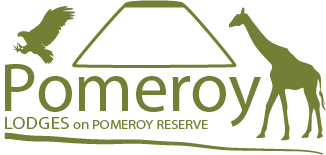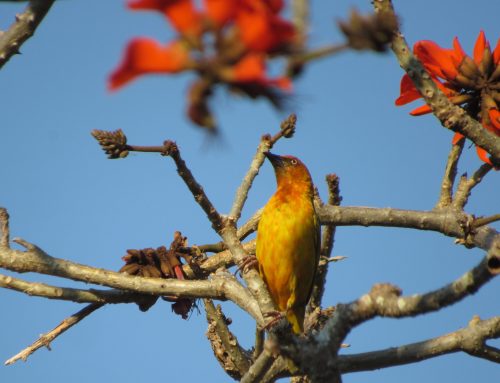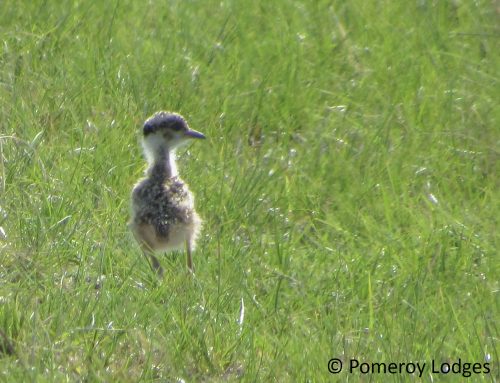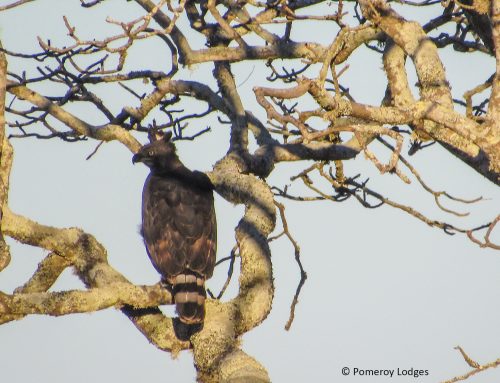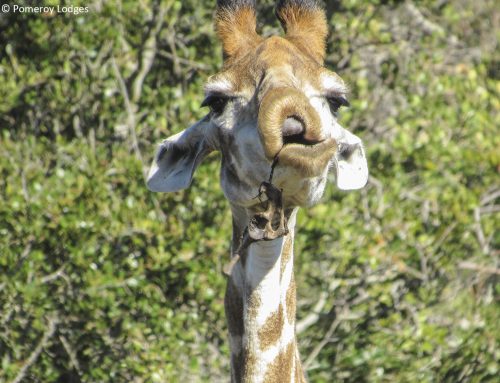POMEROY RESERVE
In the Eastern Cape of South Africa, roughly half way between East London and Port Elizabeth, off the R72, 6km up the DR2004 towards Shaw Park. That’s where we are.
Now five years on since we opened Pomeroy in 2015 as a destination for travelers wanting something off the beaten track.
Five fully fitted luxury self catering lodges stand before a line of gum trees elevated on the ridge overlooking a 330 hectare private nature reserve. Each has a private terrace. You can park your car right outside the door.
A reserve you can explore at your leisure. Easy to find tracks that cover the entire reserve. And plenty to see too. Animals, giraffe, wildebeest, impala, zebra and more. Birds, Knysna Turaco, Paradise Flycatcher, Crowned Eagle, Narina Trogon and more.
DIVERSITY
Pomeroy in South African terms of size is not large, not small. It has an area of 330 hectares. That’s about the same as 450 football pitches. The reserve lies five kilometers inland from the Indian Ocean coastline to the South East. The elevation is approximately 100 metres above sea level at its highest point.
The diversity of life is impressive for a reserve of this size. And it is the biomes that give us the diversity. Each biome represents a separate microclimate type each with its own type of vegetation. Each type of vegetation attracts a particular group of trees, flowers, plants, animals, birds, insects, amphibians and more. Pomeroy Reserve is home to 24 species of mammals that we know of, 130 bird species have been spotted. We are constantly adding to the list of flowers, plants and other animals and birds. You have to look out across the reserve to see it.
WATER.
It’s everywhere. Well, most places. And when there is none falling from the sky that we realize just how much we need it. We value the water that remains on the reserve after a heavy downpour. It fills the streams, it revitalizes the grasses, plants and trees which in turn provide new growth for the animals, birds and insects. Pomeroy has three small ponds which provide a constant source of water for the animals and birds to use. Of the three, only one is fed from a stream source. There are a couple of streams which flow through the reserve and beyond which then feeds the east Kleinemonde river which eventually leads to the Indian Ocean at Kleinemonde.
The streams and water sources directly support a wide variety of nature; from plants, like the bird of paradise flowers which we find on Pomeroy generally enjoy a wetter habitat, to Yellow weaver birds making their nests above the water surface, and the largest lizard on the reserve, the monitor lizard which can often be seen basking in the sun near the banks of the pond towards the north of the reserve.
CANOPY
For some its shelter, for others it’s a hunting ground and for some, it’s home. Life beneath the canopy is a place to forage for tasty snacks in the undergrowth, a place to roost for the night, a place to seek shelter from the weather, or to hide from predators.
Of the predators on the reserve, the African Crowned Eagle is perhaps the most prolific hunter. And for its prey, hiding under the canopy is not the smartest move. In fact the Crowned Eagle hunts under the canopy. With its broad wings and rounded tail, the Crowned Eagle is adept at maneuvering between the branches to capture prey. The usual food source is small mammals but here on Pomeroy reserve, we do notice that the Blesbok lambs are disappearing. The eagles use their massive talons for killing their prey with a brute force attack. If the prey is to large (eagles will attack animals up to 30kg), the eagles will remove a leg to take back for the nest.
GRAZING
The majority of the animals on the reserve are grazers. They need the succulent grasses to stay fit and healthy. The rains are so important to the stability of the grasses available for the animals. No rains mean the grasses die down and the animals don’t get the nutrients they so desperately need. In recent years we have substituted poor grass availability with Lucerne bales.
The level of grazing we have is always subject to the weather. Whilst the sun is essential for the grasses to grow, we also need the rains too. The reserve, due its geographical position, generally receives 300+ days of sun per year and around 600mm of rain per year.
Diversity on the reserve at Pomeroy is achieved through the different biomes present. Fynbos, Forest, Grasslands and Thicket
FYNBOS
A region of vegetation of South Africa that extends all the way from Cape Town on the South West corner to Grahamstown in the Eastern Cape. Often appearing as unimpressive, treeless scrubby patches, it is effectively heathland, resembling similar environments in Europe, Australia and South America. Fynbos translates as ‘fine-bush’ and in the main appears as fine straggly stems and leaves. However, upon closer inspection, the reality is never ending carpet of plant diversity with blooms for every season of the calendar.
The fynbos that can be seen on Pomeroy is maintained so that a fine balance can be achieved between the amount of accessible land on the reserve and the amount of grazing land for the array of animals.
FOREST
One of the smaller biomes on the reserve at Pomeroy is the forest. Confined to the belts of land either side of the streams the forest is dense. The access crosses the streams at several locations. The vegetation changes dramatically compared to the rest of the reserve. The stream banks are rich with thick with palms reaching high for the sunlight. The ground is mainly sand and is moved constantly by the wind in the dry season and the water in the wet season. The streams usually are just a trickle but after many days of torrential rain, they become a torrent.
As the forest areas are generally in the lower part of the kloofs (steep sided wooded ravine or valley) the wildlife tends to be a real mixture. The grassland animals will drink from the streams, the giraffe use the paths and tracks on the reserve to navigate the reserve so will pass through the forest, the softer ground makes for good burrows for nocturnal animals like the aardvark and honey badgers and a perfect hunting ground for mongoose and the otters. The streams do have small fish and fresh water crabs living in them. The porcupine are often spotted by the reserve camera at night by the streams.
GRASSLANDS
By far the largest biome on the reserve at Pomeroy is the grasslands. As part of the philosophy employed at Pomeroy, the grasslands are encouraged to grow and are continuously maintained for the well-being of the variety of animals. The Zebra, Kudu, Nyala, Impala, Blesbok and Wildebeest all need grazing land for survival.
The grasslands are split between sweetveld and sourveld and the difference between them relates to available water in the soil, the type of soil and the availability of nitrogen in the soils. The sweetveld is certainly popular with all the grassland animals. When the winds are from the south, the animals prefer the grasses on the lee of the main ridge, where there is some shelter.
THICKET
The very nature of thicket being an extensive intertwining of every plant, bush and tree means that unless you are as large as a giraffe or as small as a duiker it will be difficult to navigate. Sometimes called Albany Thicket, particularly in the area surrounding Pomeroy reserve, the thicket is richest in the river valleys where it contains thorny shrubs and an undergrowth of creepers and succulent plants.
There is wildlife to be found in abundance in the dense growth of the thicket from small birds feeding off the plants and berries to small antelope such as the Bushbuck. The Warthog and Bushpig tend to crash through the dense undergrowth. The giraffe wade through the less dense parts too.6
